The Battle of Timor – the Dutch and Australians kept fighting after the surrender of Netherlands East Indies.
The bombing of Darwin did bring WWII directly onto the shores of Australia. However, what is less well known is that the reason for the Japanese attack on Darwin and Broome was to destroy the Allied supply lines from Australia to the Dutch East Indies and in particular Timor.
Allied Forces at Timor at the time of the Japanese invasion
| Koepang KNIL militia battalion, 3-inch coastal gun battery, KNIL machinegun/mortar company, 4 armoured trucks; British: 79th Light AA Battery; AIF ‘Sparrow Force’: 2/40th Battalion, 2/1st Heavy Battery, 2/1st Fortress Engineers, 18th Anti-Tank Battery section, 2/11th Field Company section plus attachments; Dili KNIL militia company; AIF 2/2nd Independent Company |
Source Allies in a Bind
Soon after the bombing of Pearl Harbour (7/12/1941) the Allied forces occupied Portuguese Timor with the aim to stop the Japanese invasion. Already on December 12, 1941, a 1,400 strong detachment of the Australian army arrived in Kupang. This unit was called “Sparrow Force “ and was commanded by Lieutenant Colonel W. Legatt. Sparrow Force consisted mainly out of the Australian 8th Division’s 2/40th Battalion and of commandos of 2nd Independent Company.
Already 650 men of the Royal Dutch East-Indies’ Army (KNIL) were present in Kupang under the command of Lieutenant Colonel N. van Straten. This force was furthermore supported by 12 Lockheed Hudson light bomber aircraft of No.2 Squadron RAAF and a small unit of the British Royal Artillery’s 79th Anti-Aircraft Battery.
The Allied forces relied on supplies from Darwin (700 kms from Timor).
Just before midnight on the same day Darwin was bombed (19/2/1942) a Japanese battalion landed west of Dili and headed for the airfield.
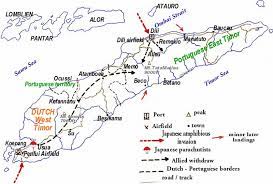
Expecting Portuguese reinforcements, the Australians withheld their fire until the Japanese were recognised by the forward position. Following a six-hour firefight, the section blew up the airfield, withdrew at dawn, avoided an ambush, and killed more Japanese before retreating to the hills.
Two Australians were killed and one was wounded and captured.
While the Japanese received the support from the mainly Muslim population of Dutch Timer, the mainly catholic people of Portuguese Timor assisted the Allied Forces. So, after their attacks on the Japanese in Dutch Timor, they were able to retreat to Portuguese Timor with the support of the local population.
After an early chaotic situation, the guerrilla troops received the support General MacArthur to fight on now as an official Allied Sparrow Force.
These Dutch and Australian troops have, with interchanging success, kept up the battle with the Japanese on Timor for almost ten months. They demolished bridges, attacked Japanese patrols and guards, conquered enemy stores and placed mines. In this way they succeeded, with primitive means, to be derogatory to the enemy.
Eventually the Japanese were able to bring more troops into Timor and the position of the Allied guerrilla forces became untenable. A very dangerous evacuation plan was developed. The Dutch destroyers van Galen and Tjerk Hiddes’ were charged with the dangerous mission. They required three dangerous trips to evacuate all guerrillas and their collaborators. The daring crossings resulting in the successful evacuations were highly praised by all allies.
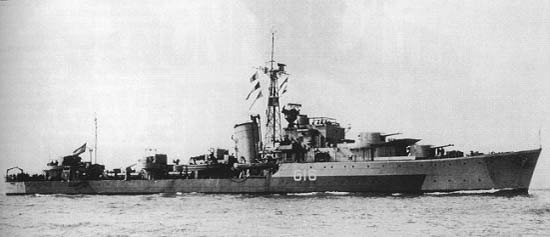
After this Netherlands East Indies Forces Intelligence Service (NEIFIS) continued undercover actions into Timor but as the previous guerrilla activities the casualties were enormous.
The guerrillas and their Portuguese and Timorese partners had prevented a whole Japanese division of 12,000 men from joining the, for the Japanese so crucial, New Guinea campaign. A very high price was paid for this: apart from the killed allied soldiers, 40,000 to 70,000 Timorese were killed or missing and many villages on Timor were largely destroyed.
The Battle for Timor had tied up the Japanese forces and therefor greatly assisted the Allied successes at the Battle of Milne Bay, New Guinea, in September 1942.
It would never come to a recapturing of Timor and the Japanese stayed in control of the island till the capitulation of Japan in August 1945. Some weeks later, on September 11th, the Japanese commander on Timor, Colonel Tatsuichi Kaida, signed for the capitulation of Timor aboard the Australian gun boat HMAS Moresby.
An official Dutch (propaganda) account of this campaign published in 1945, claimed that:
Internationally the Timor campaign brought together for the first time, Australians, Dutch and Indonesians. Fighting in small numbers and facing the same dangers, they realised the natural closeness which binds the Dutch Indies Archipelago with the fifth continent…In their subconscious, the image of the Pacific world, carried by positive uniting of the different democracies grew. (Source: Australia and the Netherlands East Indies relations during World War Two, details this operation further. By Dr. Jack Ford)
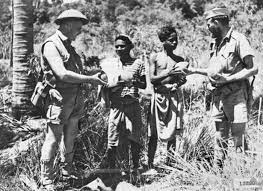
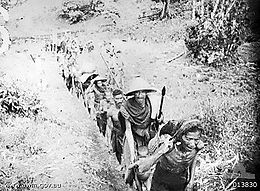
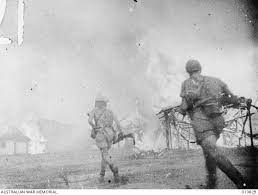
The pictures below are from a display at the Australian War Memorial taken by Paul Budde April 2024.
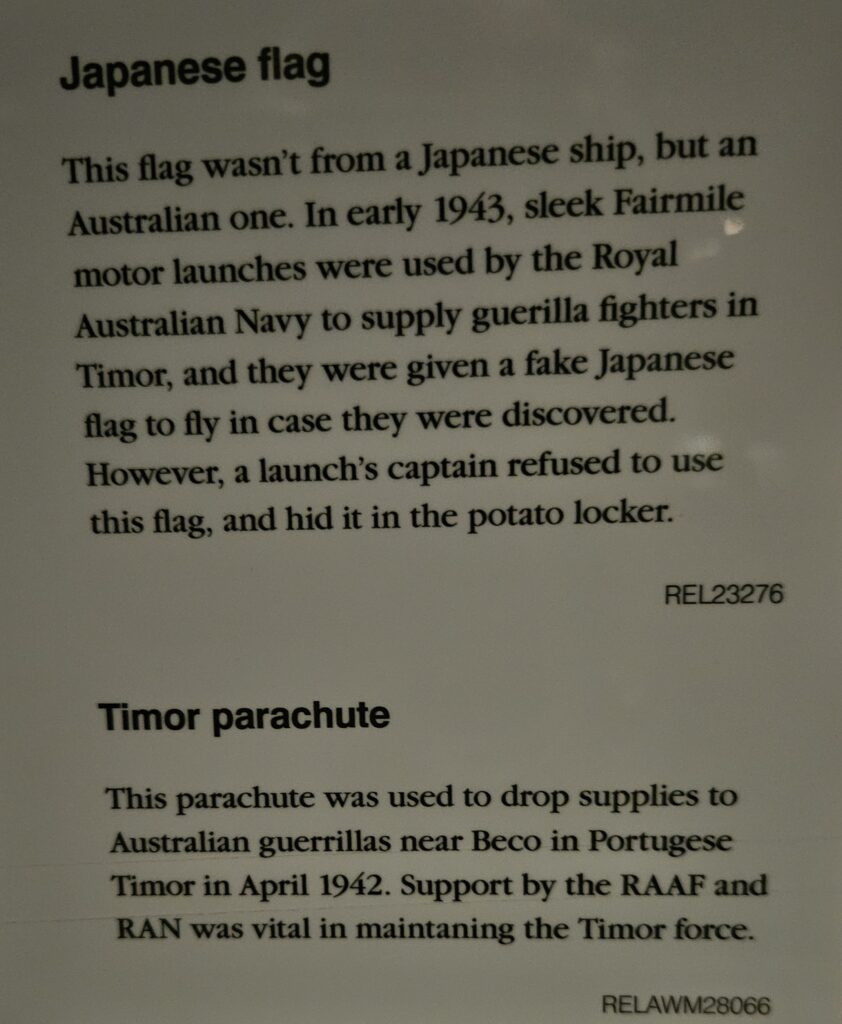
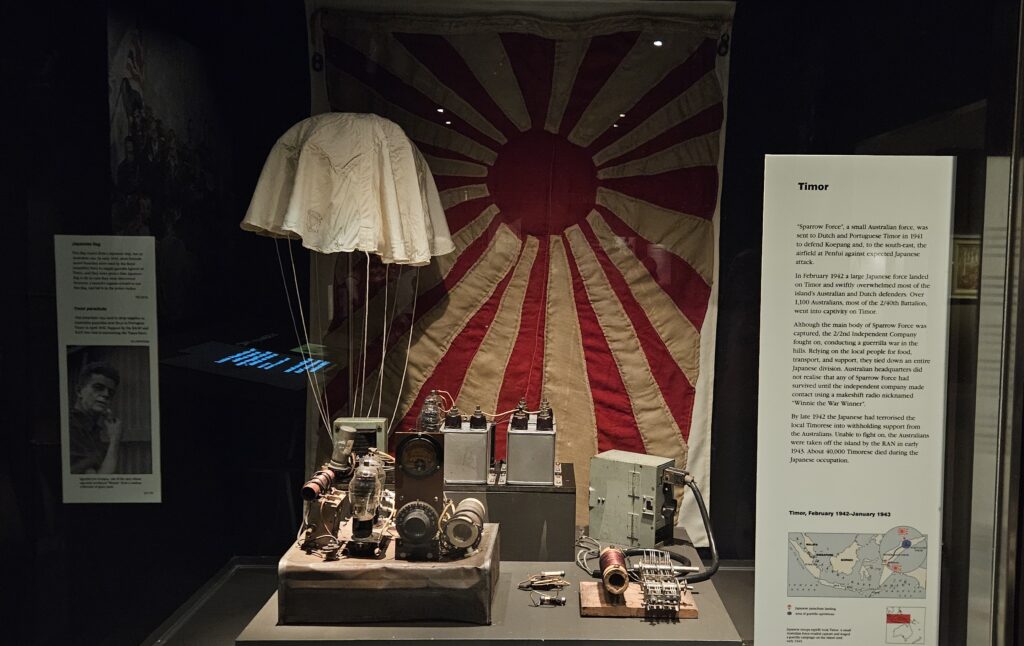
There is a website ‘Project Resistance Timor 1942‘ with the Dutch version KNIL verzet Timor 1942 that includes a number of personal stories about the guerrilla fighter of Timor together with a range of other stories about this part of WWII. There is also more information of the Facebook site Dutch-Australian Resistance Timor 1942.
The group is also preparing the publication of a book on this historic event.
The Timor veterans
After they were rescued from Timor many settled in Casino NSW and Summerville Vic. This is a photo of the Timor veterans playing in an Hawaiian party band in Summerville in 1943.

SBS Interview
Bas Kreuger works for the Netherlands Cultural Heritage Agency, among others. In November 2023 the historian visited Brisbane (Camp Columbia) and Perth on his way to East Timor to investigate bodies found in caves, which may be those of missing KNIL soldiers. In this interview with SBS (in Dutch) Bas explains how they may have ended up there. It has to do with the cooperation of the Australian and Dutch East Indies armies in February 1942 to protect Timor against the Japanese.
See also:
Major Jan Willem Zijlstra at the Battle of Timor
Ereteken voor Belangrijke Krijgsbedrijven (Expedition Cross)

Het Ereteken voor Belangrijke Krijgsbedrijven, also called the Expeditie kruis, was instituted on February 19th, 1869. It was awarded to persons participating in campaigns in the Dutch East Indies. In this it can be compared to campaign medals awarded by other countries.
The 38 mm wide yellow-green-yellow ribbon was worn with one or more clasps. A total of 33 clasps were instituted. The last WWII clasp “TIMOR 1942” was was instituted on October 29th, 1942 (K.B. no 7) and was to be awarded to those who, participated in the guerrilla war on Timor in 1941-1942 against the Japanese forces and to members of the Koninklijke Marine who evacuated these guerrilla’s to Australia.
In 2023 a new book in Dutch was published on the Timor Veterans: “Zij wilden niet buigen, De Guerrilla van het KNIL op Timor 1942”
Gerard van Haren
Gerard van Haren dedicated himself tirelessly to ensuring that his father and all Timor soldiers—both Dutch and Australian—received the recognition and gratitude they deserved. Until his final days, Gerard worked with unwavering commitment to bring their stories to light and preserve their legacy.
He made significant contributions to uncovering the history of the Dutch Timor soldiers of the Royal Netherlands East Indies Army (KNIL), who fought a valiant but unequal battle against the invading Japanese forces on the island of Timor in 1942. The sacrifices these soldiers made had been largely forgotten in the Netherlands and Australia, but Gerard’s dedication helped to change that.
Through his involvement in the Project Team “Resistance Timor 1942,” Gerard played a key role in the in developing of the website www.verzettimor1942.nl and publication of the above mentioned critically acclaimed book Zij wilden niet buigen (They Refused to Bow) offer detailed accounts of the guerrilla warfare carried out by the KNIL alongside the Australian Army on Timor in 1942, ensuring this important chapter of history is preserved for future generations.
Gerard van Haren passed away in Nijmegen on November 18, 2024
There are also ‘Timor’ files online in the National Archives on the Dutch forces in Timor. Here are some of them:
https://recordsearch.naa.gov.au/SearchNRetrieve/Interface/ViewImage.aspx?B=265907
https://recordsearch.naa.gov.au/SearchNRetrieve/Interface/ViewImage.aspx?B=235205
https://recordsearch.naa.gov.au/SearchNRetrieve/Interface/ViewImage.aspx?B=235224
https://recordsearch.naa.gov.au/SearchNRetrieve/Interface/ViewImage.aspx?B=235225
https://recordsearch.naa.gov.au/SearchNRetrieve/Interface/ViewImage.aspx?B=181017
https://recordsearch.naa.gov.au/SearchNRetrieve/Interface/ViewImage.aspx?B=550264


